

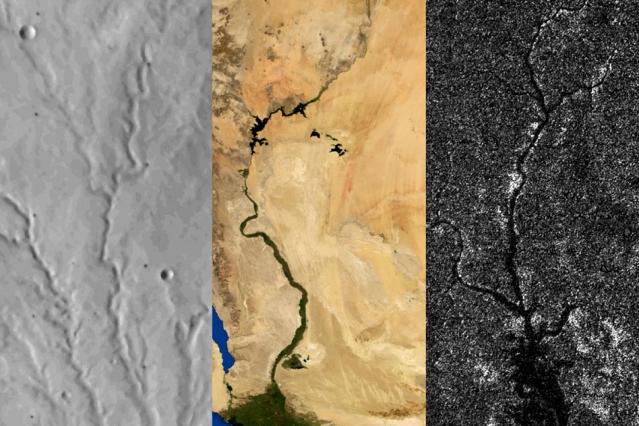
Rivers on three planetary bodies: the dry Parana Valles on Mars (left), the Nile River on Earth (middle), and Vid Flumina on Titan (right). Image by Benjamin Black using NASA data.
One of the more distinctive things about Earth among the planets is that we have plate tectonics. In other words, the hard, outer shell of the planet (called the lithosphere) is divided into several cool, rigid plates that float atop a hotter, more fluid layer of rock (the asthenosphere). These rigid surface plates do not float placidly: their grinding, colliding, shifting, and diving causes earthquakes, fuels volcanoes, builds mountains, tears open oceans, and constantly remodels and resurfaces the planet.
That is a far cry from what is happening on Mars and Titan, according to a recent study published in Science. Researchers came to that conclusion by carefully analyzing the way rivers cut through each of these planetary bodies. On Earth, countless rivers and streams snake their way across the surface. On Mars, rivers dried up long ago, but evidence of their presence remains etched into the arid surface. On Titan, Saturn’s largest moon, rivers of liquid ethane and methane still flow into lakes.

Artist’s cross section illustrating the main types of plate boundaries on Earth. (Cross section by José F. Vigil from This Dynamic Planet—a wall map produced jointly by the U.S. Geological Survey, the Smithsonian Institution, and the U.S. Naval Research Laboratory.)
By comparing imagery and data from all three planetary bodies, researchers noticed distinctive bends in the courses of rivers on Earth; these were formed as rivers were forced to wind around mountain ranges. These bends were absent in river networks on Mars and Titan. In an MIT press release, Benjamin Black, a geologist at the City College of New York, explained:
“Titan might have broad-scale highs and lows, which might have formed some time ago, and the rivers have been eroding into that topography ever since, as opposed to having new mountain ranges popping up all the time, with rivers constantly fighting against them.”
Read more about the study from New Scientist, Space.com, and the American Association for the Advancement of Science. Read the full study in Science. Read this NASA Earth Observatory story to learn more about how scientists are using satellites to study river width on Earth.
In the triptych at the top of the page, the image of Parana Valles on Mars was acquired by the Viking 1 orbiter on September 13, 1976. The image of the Nile was captured by NASA’s Terra satellite on August 10, 2000. NASA’s Cassini spacecraft captured the image of Vid Flumina on Titan on September 26, 2012.
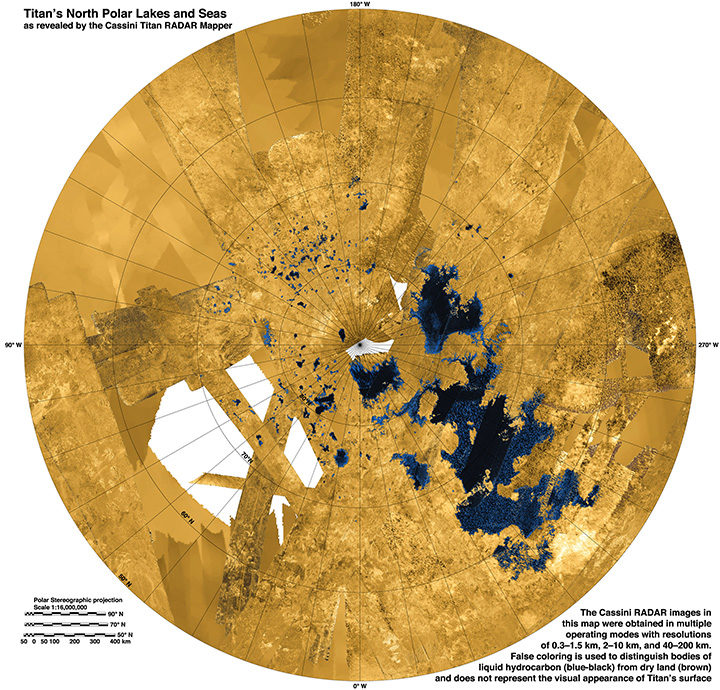
While water does not flow on Titan, rivers of methane and ethane flow into lakes near the moon’s northern pole. Learn more about this image from the NASA Jet Propulsion Laboratory Photojournal.
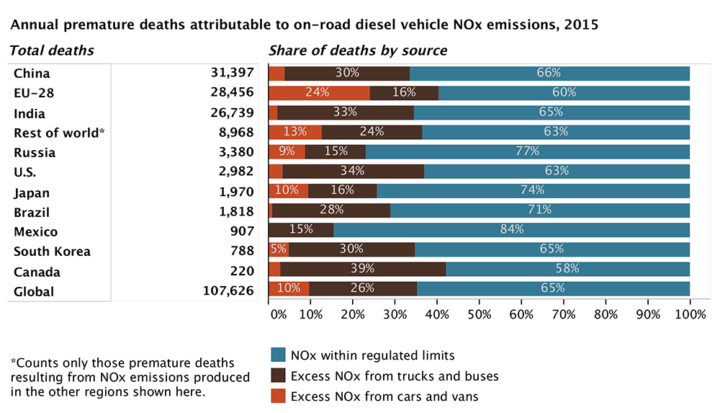
Figure by the ICCT based on data from Anenberg et al. 2017.
It is no secret that many diesel cars and trucks emit more pollution under real-world driving conditions than during laboratory certification testing. Many lab tests, for instance, are run with perfectly maintained vehicles on flat surfaces in ideal conditions. In the real world, drivers chug up hills or sit in traffic in bad weather in vehicles well past their prime.
Until this month, nobody had tallied the health effects of all the excess diesel air pollution entering the atmosphere through real-world driving conditions. According to a new study published in Nature, vehicles in eleven major markets (Australia, Brazil, Canada, China, Europe, India, Japan, Mexico, Russia, South Korea, and the United States) emitted about 4.6 million more tons of nitrogen oxides (NOx) in 2015 than official laboratory tests suggested they would. NOx contributes to the accumulation of both ground-level ozone (O3) and fine particulate matter (PM2.5) in the atmosphere.
According to the research team, nearly one-third of heavy-duty diesel vehicle emissions and over half of light-duty diesel vehicle emissions are above the certification limits. On average, light-duty diesel vehicles produce 2.3 times more NOx than the limit; heavy-duty diesel vehicles emit more than 1.45 times the limit.
The authors of the study calculated the health effects for current and future levels of this excess diesel NOx by running a global atmospheric chemistry model that simulates the distribution of PM2.5 and O3. The bottom line: excess NOx caused 38,000 premature deaths in 2015. It could cause as many as 183,600 premature deaths by 2040 as the use of diesel increases.
“We estimate that excess diesel NOx emissions from on-road trucks, buses, and cars leads to upwards of 1,100 premature deaths per year in the U.S.,” said Daven Henze, a professor of mechanical engineering at the University of Colorado and member of NASA’s Health and Air Quality Applied Sciences Team.
Other key findings from the study:
For more information, read a press release and fact sheet from the International Council on Clean Transportation, a press release from the University of Colorado, and a press release from the University of York. To find out more about global air pollution trends, read A Clearer View of Hazy Skies from NASA Earth Observatory.
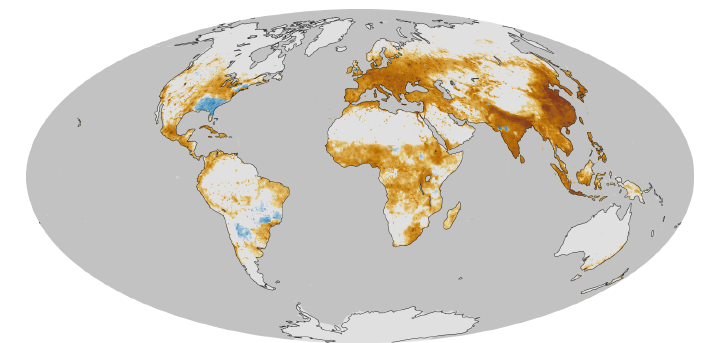

This map, based on previous research, shows a model estimate of the average number of deaths per 1,000 square kilometers (386 square miles) per year due to fine particulate matter (PM2.5), a type of outdoor air pollution. Pollution from diesel exhaust is one contributer to PM2.5. Earth Observatory image by Robert Simmon based on data provided by Jason West. Learn more about this map here.
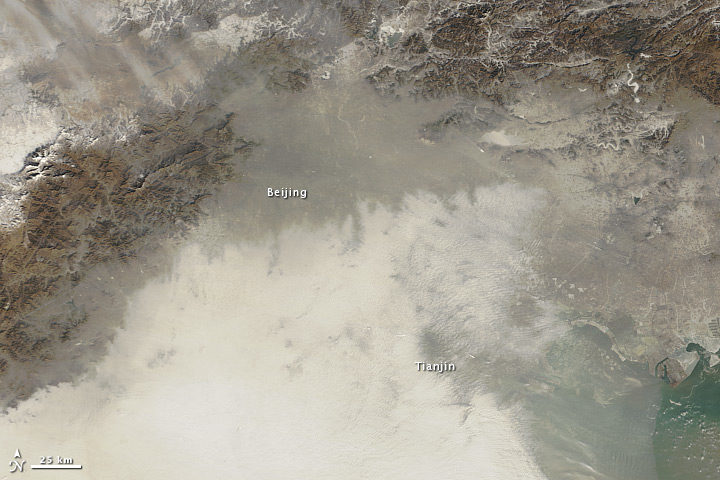
Haze over northeastern China on January 14, 2013. Image by NASA Earth Observatory, using data Terra MODIS data from LANCE MODIS Rapid Response.
In the winter of 2013, thick haze enveloped northern China for several weeks. On January 12, 2013, the peak of that bad-air episode, the air quality index (AQI) rose to a staggering 775—off the U.S. Environmental Protection Agency scale—according to a U.S. air quality sensor in Beijing.
Extra pollution from cars, homes, and factories in the winter often sets the stage for outbreaks of air pollution in China. But a March 2017 study in Science Advances suggests that a loss of Arctic sea ice in 2012 and increased Eurasian snowfall the winter before may have helped fuel the extreme event.
Snow and ice cover can affect weather patterns because both affect albedo, a measure of how much solar radiation the surface reflects in comparison to how much incoming solar radiation it receives. In September 2012, sea ice covered less area than at any other time since 1979. Meanwhile, Eurasia had unusually high snow cover in December 2012, the second most on a record that dates back to 1967.
Normally, winds blow air pollution away from eastern China, which is home to Beijing and several other large cities. But in January 2013, winds died down to a whisper and air pollution piled up. By analyzing decades of data collected by ground-based weather stations, 15 years of satellite data on aerosols, and computer simulations of the atmosphere, the researchers concluded that unusual sea ice and snow conditions triggered a shift in China’s winter monsoon, stilling the winds that normally ventilate Beijing.
A press release from Georgia Tech explained the connection in more detail:
“The reductions in sea ice and increases in snowfall have the effect of damping the climatological pressure ridge structure over China,” explained Yuhang Wang. “That flattens the temperature and pressure gradients and moves the East Asian Winter Monsoon to the east, decreasing wind speeds and creating an atmospheric circulation that makes the air in China more stagnant.”
If correct, this might explain why efforts to reduce air pollution in recent years have not stopped extreme haze events from happening. “Emissions in China have been decreasing over the last four years, but the severe winter haze is not getting better,” said Wang. “Mostly, that’s because of a very rapid change in the high polar regions.”
This is not the first study that connects changes in the Arctic to severe haze in China. Research published in August 2015 in Atmospheric Oceanic Science Letters argued that a decline in Arctic sea ice intensifies haze in eastern China. And a study published in Nature Climate Change in April 2017 came to a similar conclusion. The latter study projected a 50 percent increase in the frequency of extreme haze events and an 80 percent increase in their persistence in the near future.
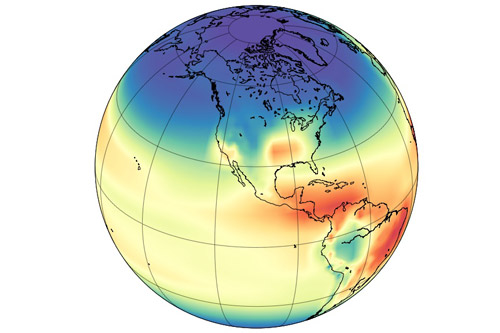
Model simulation of the hydroxyl radical concentration in the atmosphere. Image by Angharad Stell, University of Bristol.
A mystery about global methane trends just got more muddled. Two studies published in April 2017 suggest that recent increases in atmospheric concentrations of methane may not be caused by increasing emissions. Instead, the culprit may be the reduced availability of highly reactive “detergent” molecules called hydroxyl radicals (OH) that break methane down.
Understanding how globally-averaged methane concentrations have fluctuated in the past few decades—and particularly why they have increased significantly since 2007—has proven puzzling to researchers. As we reported last year:
“If you focus on just the past five decades—when modern scientific tools have been available to detect atmospheric methane—there have been fluctuations in methane levels that are harder to explain. Since 2007, methane has been on the rise, and no one is quite sure why. Some scientists think tropical wetlands have gotten a bit wetter and are releasing more gas. Others point to the natural gas fracking boom in North America and its sometimes leaky infrastructure. Others wonder if changes in agriculture may be playing a role.”
The new studies suggest that such theories may be off the mark. Both of them find that OH levels may have decreased by 7 to 8 percent since the early 2000s. That is enough to make methane concentrations increase by simply leaving the gas to linger in the atmosphere longer than before.

Atmospheric methane has continued to increase, though the rate of the increase has varied considerably over time and puzzled experts. (NASA Earth Observatory image by Joshua Stevens, using data from NOAA. Learn more about the image.)
As a press release from the Jet Propulsion Laboratory (JPL) noted: “Think of the atmosphere like a kitchen sink with the faucet running,” said Christian Frankenberg, an associate professor of environmental science and engineering at Caltech and a JPL researcher. “When the water level inside the sink rises, that can mean that you’ve opened up the faucet more. Or it can mean that the drain is blocking up. You have to look at both.”
Unfortunately, neither of the new studies is definitive. The authors of both papers caution that high degrees of uncertainty remain, and future work is required to reduce those uncertainties. “Basically these studies are opening a new can of worms, and there was no shortage of worms,” Stefan Schwietzke, a NOAA atmospheric scientist, told Science News.
You can find the full studies here and here. The University of Bristol has also published a press release.
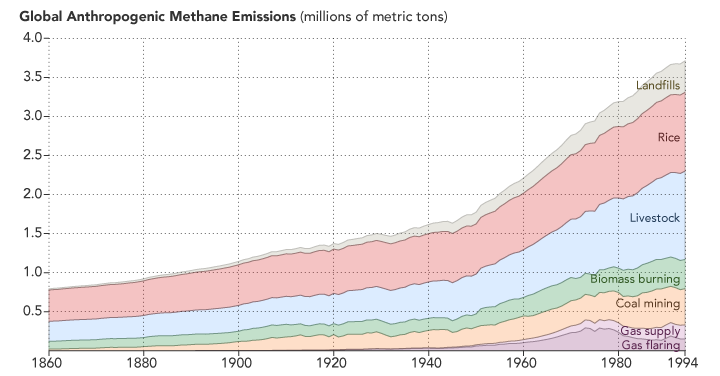
Methane emissions related to human activity are on the rise. (NASA Earth Observatory image by Joshua Stevens, using data from CDIAC. Learn more.)
You want to know what is better than a “Celebration of Clouds” (our recent photo essay)? A slideshow of clouds set to music. A slideshow you can use to hook your friends and family on Earth science.
So sit back, push play, and take a tour of Earth’s elegant atmosphere. Then share the beauty.
Our focus at Earth Observatory has long been still imagery and data-intensive maps. But lately we have been supplementing some stories with video and animations. For instance, check out this narrated video about the Chesapeake Bay Watershed. It’s a relatively new direction for us, so please let us know what you think.
On top of all the great science they make possible, satellites often produce imagery that is simply beautiful.
This image of Turnabout Glacier on Canada’s Ellesmere Island is a case in point. It shows a classic piedmont glacier that looks almost like pancake batter spilling over a frozen landscape. Piedmont glaciers form when steep valley glaciers spill out into relatively flat plains. Unchained from the constraints of the terrain, the ice flows freely in all directions.

Image Credit: NASA Earth Observatory/ASTER/Jesse Allen
The Advanced Spaceborne Thermal Emissions and Reflection Radiometer (ASTER) instrument on NASA’s Terra satellite acquired an image of the glacier and its surroundings on July 26, 2009. The summertime image shows the glacier free of overlying snow from the previous winter. Banding in the surface of the ice shows different years in which the ice was laid down on the glacier.
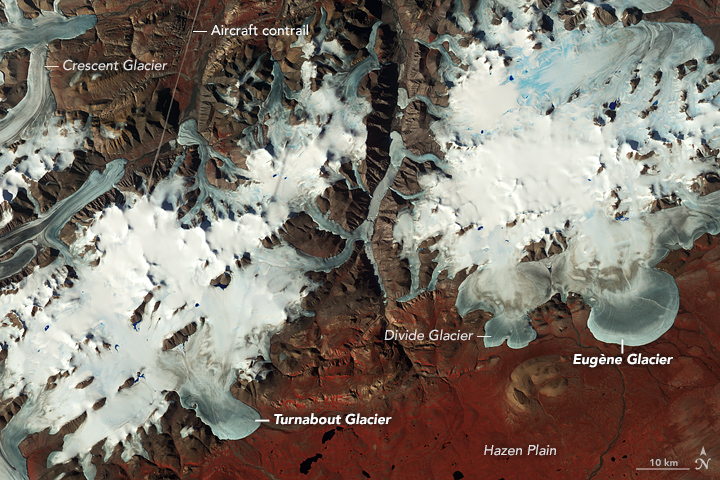
Image Credit: NASA Earth Observatory/ASTER/Jesse Allen
In the wider view, you can see glaciers drain out of ice caps between mountain peaks and ridgelines. Many features, including Turnabout, were first formally cataloged in 1957 and 1958 as part of the first International Geophysical Year (IGY). This area is so far north and the weather so cold much of the year that there has been little in the way of human footprints on the landscape. Hence, features had no official names within the scientific community before the IGY.
Humans have, though, made one visible impact on this image. The line on the top left is a contrail from a plane. Contrails form when water-rich exhaust from jet engines freezes into tiny ice crystals at high altitude.
Compare Turnabout to Eugène Glacier in the wider view. Both are classic piedmont glaciers, but Turnabout exits the mountain pass into the Hazen Plain with some obstacles that cause it to twist and turn before ending and draining into the Turnabout River. Eugène Glacier has no such obstacles and spreads out more evenly.
This false-color image was made by combining observations of near infrared, red, and green light. Red indicates vegetation; the chlorophyll in plants reflects much more strongly in the near infrared than other wavelengths.

By removing natural and stray light sources, researchers have provided a clearer picture of the human footprint on Earth. Learn more about this image. (NASA Earth Observatory image by Joshua Stevens, using Suomi NPP VIIRS data from Miguel Román, NASA GSFC.)
As we arrive at Earth Day 2017, reporting on Earth science can sometimes feel like a gloomy affair. Global temperatures are at record highs. Arctic sea ice is in pretty bad shape. Bleaching events are taking a toll on coral reefs. And as an interesting article in EOS recently noted, humanity is affecting the very shape of Earth’s surface in unprecedented ways.
“We have altered flood patterns, created barriers to runoff and erosion, funneled sedimentation into specific areas, flattened mountains, piled hills, dredged land from the sea, and even triggered seismic activity,” the authors wrote. (Read our stories about land reclamation in China, mining in Canada, gas and oil infrastructure in Texas, the growing Wax Lake Delta in Louisiana, and the retreat of the Aral Sea to see changes of this nature.)
In spite of the challenges in a changing world, there are reasons to be optimistic. The world has come together to confront global problems before. Levels of protective ozone are stabilizing because of the Montreal Protocol. In the United States and Europe, better technology and regulations have led to drastic reductions in air pollutants such as sulfur dioxide and nitrogen dioxide. There are signs that efforts to clean up the Chesapeake Bay are making a difference.
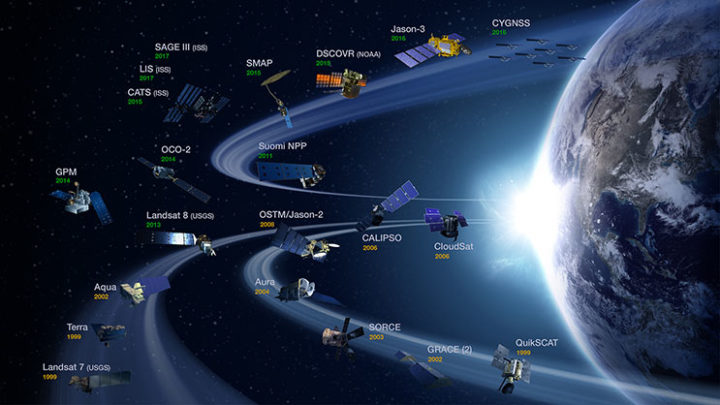
NASA’s operating Earth science missions as of March 31, 2017. (Image Credit: NASA’s Earth Observing Project Science Office.)
Some of the environmental challenges we face are daunting and can seem intractable, but there are some good reasons to feel reassured by the tools and expertise that the scientific community brings to the table. Americans live in a country where the number of deaths due to hurricanes, landslides, floods, droughts, tornadoes, blizzards, and other weather hazards have plummeted over the past century, and that is largely due to better understanding and to appropriate hazards warning systems that Earth scientists have developed.
Computers and instruments that used to take up whole rooms now fit snugly onto autonomous aircraft, satellites, and robots. At this moment, 1,459 satellites orbit Earth—including 19 that are part of the NASA fleet keeping a watchful eye on this dynamic, fragile planet. The authors of the EOS article note that a unified, global, high-resolution 3-D map of the human fingerprint on Earth is within reach due to the remarkable lidar instruments, aerial photogrammetry, and satellite observations that are now available.

NASA invites people around the world to help us celebrate Earth Day 2017 by “adopting” one of 64,000 individual pieces of Earth as seen from space. Learn more. (Image Credit: NASA)
To get a sense of the sophistication and breadth of the information satellites now collect, just navigate to your home town with NASA’s Worldview browser or take a look at the Earth Observations (NEO) data archive. You will find information on everything from plant health to particulate aerosol levels to fires to city lights.
As you look, keep in mind that NASA isn’t just collecting that data for data’s sake. The Applied Sciences program is focused on making that data useful to citizens, resource managers, and civic planners in ways that make life better here on Earth. So if you plan to celebrate Earth Day by cleaning up trash in your neighborhood or adopting a piece of the planet with NASA, rest assured that you are not alone in working to make the planet just a little bit more livable.
Scientists have long known that moisture content in the thin, top layers of soil plays an important role in global water processes. Recent findings published in Nature Geoscience show that roughly 14 percent of all rainfall remains in the uppermost soil layer for as long as three days after a storm. According to data from NASA’s Soil Moisture Active Passive mission (SMAP), that’s especially true for Earth’s driest regions.
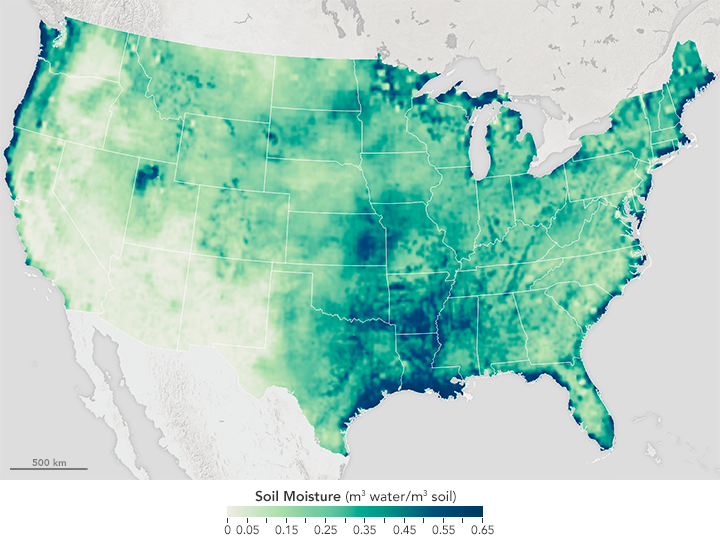
Soil moisture varied widely in this image, which uses data gathered between May 27–31, 2015. Image by Joshua Stevens/NASA Earth Observatory.
“It’s sitting at a very critical zone at the surface of the land, and plays a disproportionately critical role in the cycling of water,” said Dara Entekhabi, a professor at MIT and author of the study, in a press release. “It plays a significant role in moderating climate on seasonal and annual timescales.”
The top 2 inches (5 centimeters) of surface soil contains a sort of “memory”—even several days after a heavy rainfall, the soil will contain a fraction of that moisture. Such memory can affect weather, farming, the spread of vector-borne diseases and the length of droughts and floods.
For more on SMAP, check out some of these NASA Earth Observatory stories:
+Soil Moisture in the United States
+Soggy Soil in the Eastern United States
Here’s a roundup of some of the latest Earth science news from NASA.
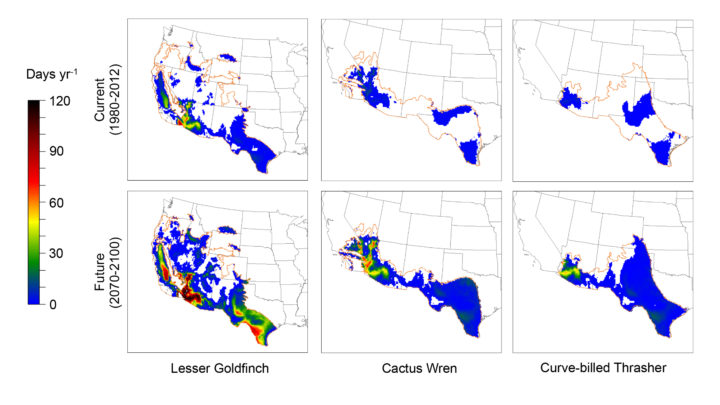
The number of days with lethal dehydration risk rises in a future scenario where the Earth warms by 7 degrees Fahrenheit. Credit: NASA
MORE HEAT, LESS SINGING
Longer, more intense, and more frequent heatwaves threaten U.S. songbirds, according to a recent study. In a scenario where temperatures increase by 4 degrees Celsius (7 degrees Fahrenheit), five species of songbirds will become more prone to mass die-offs due to dehydration. Researchers used data from the North American Land Data Assimilation System (NLDAS) and physiological data in the study. Read more here.
CHILLING AND DRILLING UNDER EREBUS
This spring, scientists descended into ice caves below Mount Erebus—the entrance to the underworld, according to the ancient Greeks. Aaron Curtis, a postdoctoral scholar at NASA’s Jet Propulsion Laboratory, used the icy environment to test robots, a drill, and computer-aided mapping technology. The tests were intended to explore and simulate how these tools might perform on icy planets. Read more here.
SAGE WATCHES OVER OZONE
How thick is the Earth’s ozone layer now, after years of depletion, regulation, and recovery? The Stratospheric Aerosol and Gas Experiment (SAGE) III instrument is set to monitor “the Earth’s sunscreen,” as well as other gases and particles, from the International Space Station. Following its installation in March 2017, SAGE will keep a pulse on ozone, water vapor, and aerosols in our atmosphere.
Editor’s note: Here’s a roundup of the latest eye-catching earth science videos from NASA and beyond. In March, snow emerged as a theme.
Where there is snow, there is water. Scientists trudged through thick white powder in Grand Mesa and the Senator Beck Basin to measure the depth of snow — and its water content — for the SnowEx campaign.
SIX SIDES AND A WHOLE LOT O’ COOL
A scientist with the Global Precipitation Measurement (GPM) mission explains why snowflakes look the way they do.
SIX THINGS YOU DON’T KNOW ABOUT SNOW
Did you know that 60 million Americans rely on snowmelt as their main source of water?
And if you’re not completely buried in white stuff, check out a National Geographic short documentary on a Colorado man who has been taking daily snow measurements for decades.
JUMPING TO LIGHT SPEED IN THE PURSUIT OF SNOW
“Photon Jump” tells the story of an exuberant photon. Follow this miniature light particle as s/he is spat out of a satellite sensor in Earth’s orbit. A team of students at Georgia’s Savannah College of Art and Design (SCAD) created the film for the upcoming ICESat-2 mission, which will measure snow and ice on Earth.